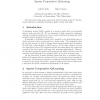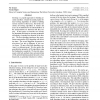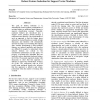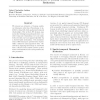ICML
2004
IEEE
16 years 1 months ago
2004
IEEE
114
click to vote
ICML
2004
IEEE
16 years 1 months ago
2004
IEEE
Kernel conditional random fields (KCRFs) are introduced as a framework for discriminative modeling of graph-structured data. A representer theorem for conditional graphical models...
108
click to vote
ICML
2004
IEEE
16 years 1 months ago
2004
IEEE
Boosting is a popular approach for building accurate classifiers. Despite the initial popular belief, boosting algorithms do exhibit overfitting and are sensitive to label noise. ...
89
Voted
ICML
2004
IEEE
16 years 1 months ago
2004
IEEE
Motivated by the interest in relational reinforcement learning, we introduce a novel relational Bellman update operator called ReBel. It employs a constraint logic programming lan...
107
click to vote
ICML
2004
IEEE
16 years 1 months ago
2004
IEEE
The goal of feature induction is to automatically create nonlinear combinations of existing features as additional input features to improve classification accuracy. Typically, no...
87
Voted
ICML
2004
IEEE
16 years 1 months ago
2004
IEEE
We present an extension of Isomap nonlinear dimension reduction (Tenenbaum et al., 2000) for data with both spatial and temporal relationships. Our method, ST-Isomap, augments the...
105
click to vote
ICML
2004
IEEE
16 years 1 months ago
2004
IEEE
We compute a common feature selection or kernel selection configuration for multiple support vector machines (SVMs) trained on different yet inter-related datasets. The method is ...
101
click to vote
ICML
2004
IEEE
16 years 1 months ago
2004
IEEE
In this paper we focus on the adaptation of boosting to grammatical inference. We aim at improving the performances of state merging algorithms in the presence of noisy data by us...
97
Voted
ICML
2004
IEEE
16 years 1 months ago
2004
IEEE
Predictive state representations (PSRs) are a recently proposed way of modeling controlled dynamical systems. PSR-based models use predictions of observable outcomes of tests that...
79
Voted
ICML
2004
IEEE
16 years 1 months ago
2004
IEEE
Attribute interactions are the irreducible dependencies between attributes. Interactions underlie feature relevance and selection, the structure of joint probability and classific...




